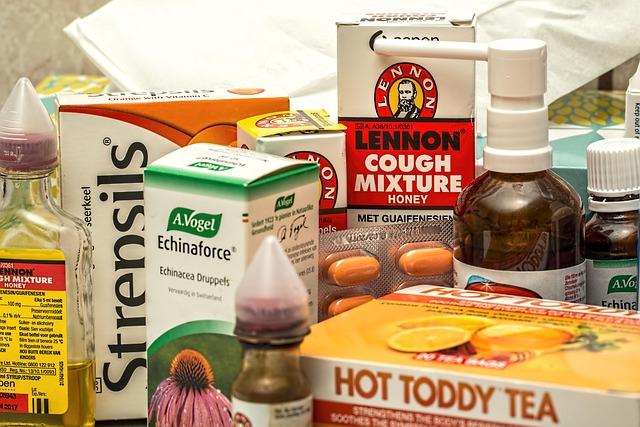Table of Contents
- Understanding Diaper Rash: Causes and Symptoms
- Effective Home Remedies for Diaper Rash Relief
- Top Over-the-Counter Treatments to Consider
- When to Seek Professional Help for Persistent Diaper Rash
- Preventative Measures to Keep Diaper Rash at Bay
- Q&A
- Wrapping Up


Understanding Diaper Rash: Causes and Symptoms
Diaper rash can result from several factors, making it crucial for parents to recognize the underlying causes. One of the primary contributors is prolonged exposure to moisture. When wet diapers are left unchanged for extended periods, they create an environment where bacteria and yeast can thrive, leading to inflammation. Additionally, friction caused by diaper elastic and rough materials can irritate the sensitive skin of infants. It’s also important to consider allergies, whether from the materials used in diapers or from certain products, such as wipes and creams, which might clash with a baby’s delicate skin.
Identifying symptoms early can make a significant difference in treatment. Rash usually manifests as red, inflamed patches that can vary in severity from mild redness to raw, blister-like sores. Other indicators include:
- Discomfort or fussiness: Babies might show signs of distress when their diaper is being changed.
- Warmth: The affected area often feels warmer to the touch.
- Chafing and scaling: Skin may appear rough and dry in addition to being discolored.
Understanding the common triggers for diaper rash can aid in prevention and effective treatment. Factors such as changing diets, medications (like antibiotics), and increased bowel movements can play a role in susceptibility. Keeping a structured routine for diaper changes, ensuring proper air circulation to the diaper area, and using gentle, hypoallergenic products can make a substantial difference. Here’s a quick reference table of common triggers and preventive measures:
| Trigger | Preventive Measure |
|---|---|
| Prolonged wetness | Frequent diaper changes |
| Friction | Soft, breathable diapers |
| Food sensitivities | Monitor diet changes |
| Products with irritants | Opt for fragrance-free options |
Effective Home Remedies for Diaper Rash Relief
One of the most effective home remedies for diaper rash involves the natural power of coconut oil. Renowned for its antibacterial and antifungal properties, coconut oil can help soothe irritated skin and create a protective barrier against further moisture irritation. To apply, gently massage a thin layer onto the affected area after each diaper change, allowing it to absorb fully. This not only promotes healing but also leaves the skin feeling softer.
Another popular remedy is the use of oatmeal baths. Oatmeal is known for its anti-inflammatory properties and can provide significant relief from redness and itching. To prepare an oatmeal bath:
- Grind plain oats into a fine powder.
- Add a cup of this powder to warm bath water.
- Let your baby soak for about 15 minutes to soothe the skin.
Be sure to gently pat the skin dry afterward to avoid further irritation.
For those looking for a quick spot treatment, aloe vera gel is a fantastic choice due to its soothing and healing effects. Simply apply pure aloe vera gel to the affected area several times a day for optimal results. Additionally, employing a baking soda paste can help restore the skin’s pH balance. Mix one tablespoon of baking soda with a small amount of water to create a paste, then apply it to the rash for 10-15 minutes before rinsing off. Both of these remedies provide complementary treatment options to promote healing and comfort in sensitive areas.


Top Over-the-Counter Treatments to Consider
When it comes to diaper rash, choosing the right over-the-counter treatment can make all the difference for your little one’s comfort. Here are some effective options that parents swear by:
- Barrier Creams: Formulated to create a protective layer on the skin, these creams help to lock in moisture and shield against irritants. Look for ingredients like zinc oxide or petrolatum for the best results.
- Antifungal Ointments: If you suspect that a yeast infection is contributing to the rash, antifungal creams can be a game changer. Products containing clotrimazole or miconazole can effectively treat and soothe the area.
- Hydrocortisone Creams: For particularly stubborn rashes that don’t improve with regular creams, a mild hydrocortisone cream can help reduce inflammation. Use it sparingly and only as directed.
Another handy tool for diaper rash prevention is the use of creams that contain natural ingredients. You might consider options infused with aloe vera or coconut oil, which not only soothe but also provide moisture without harsh chemicals. These can be particularly beneficial for sensitive skin:
| Natural Ingredient | Benefits |
|---|---|
| Aloe Vera | Soothes and hydrates irritated skin. |
| Coconut Oil | Antimicrobial properties that prevent infection. |
| Calendula Extract | Calms inflammation and promotes healing. |
In addition to using topical treatments, consider implementing effective diaper changing habits. Frequent changes can help minimize moisture exposure. During diaper changes, gently clean the area with a soft cloth and warm water, and let the skin air dry before applying any product. The right combination of treatments and preventive measures can significantly reduce discomfort and speed up healing.


When to Seek Professional Help for Persistent Diaper Rash
Understanding when to involve a healthcare professional can be crucial for effectively treating persistent diaper rash. If you notice that the rash worsens or remains unchanged after a few days of at-home treatment with creams or ointments, it may be time to consult a doctor. Persistent irritation can indicate other underlying issues that require expert evaluation. Additionally, if you observe any signs of infection, such as increased redness, swelling, or discharge, immediate medical attention is essential.
Another critical indicator for seeking professional help is if your little one displays signs of discomfort or pain. If your baby becomes unusually fussy, refuses to eat, or appears distressed during diaper changes, trust your parental instincts and reach out to a healthcare provider. Your child’s well-being is the priority, and any persistent signs of discomfort should be taken seriously.
Lastly, recurrent diaper rash episodes may suggest that your child has a sensitivity to specific products, such as wipes or diapers. In this case, a conversation with your pediatrician can help identify the root cause of the irritation. They might recommend switching to hypoallergenic or fragrance-free products that are gentler on your baby’s skin. Here’s a quick reference for commonly suggested products:
| Product Type | Recommended Features |
|---|---|
| Diapers | Breathable, Hypoallergenic |
| Wipes | Fragrance-Free, Alcohol-Free |
| Rash Cream | Barrier Cream with Zinc Oxide |


Preventative Measures to Keep Diaper Rash at Bay
Keeping diaper rash at bay involves a combination of consistent skincare practices and a few simple adjustments to your routine. Regular diaper changes are crucial; changing the diaper as soon as it becomes wet or soiled can significantly reduce the risk of irritation. Aim to check your baby’s diaper every couple of hours and change it promptly. In addition, consider using highly absorbent diapers that wick moisture away from your baby’s skin, helping to keep them dry and comfortable.
After each change, take a moment to gently cleanse the diaper area. This can be done using a soft, damp cloth or gentle, alcohol-free wipes to remove any lingering moisture or residue. It’s important not to scrub the area forcefully; instead, pat it dry to prevent any further irritation. Once cleaned, apply a thin layer of diaper ointment or barrier cream. Look for products that contain ingredients like zinc oxide or petroleum jelly, as these form a protective layer over the skin.
Lastly, allow for air circulation whenever possible by letting your baby go diaper-free for short periods. This can significantly help in preventing diaper rash. If diaper rash does occur, consider integrating cloth diapers during the healing process, which can be less irritating than some disposable options. Remember that diet can also play a role; introducing new foods to your baby may sometimes affect their skin. Keep track of any correlations and adjust their diet if you notice any patterns related to diaper rash.
Q&A
Q&A: Best Diaper Rash TreatmentQ1: What is diaper rash, and what causes it? A1: Diaper rash, also known as dermatitis, is a common skin condition that affects babies, typically manifesting as red, inflamed patches on the skin covered by a diaper. It often results from prolonged exposure to moisture, friction, and irritants found in urine and stool. Other factors can include diaper type, sensitivity to baby wipes or laundry detergents, and even introducing new foods that affect stool consistency.Q2: How can I prevent diaper rash? A2: Prevention is key when it comes to diaper rash. Here are several effective strategies:
- Frequent Diaper Changes: Change your baby’s diaper promptly when wet or soiled to minimize skin exposure to irritants.
- Air Exposure: Allowing your baby some diaper-free time can significantly reduce moisture and promote healing.
- Gentle Cleaning: Use soft wipes or a damp cloth to clean the diaper area. Avoid harsh soaps or wipes with alcohol or fragrances.
- Choose the Right Diapers: Opt for high-quality, absorbent diapers that fit well and reduce friction.
Q3: What are the best treatments for existing diaper rash? A3: Treating diaper rash effectively involves a few critical steps:
- Barrier Creams: Look for products containing zinc oxide or petroleum jelly that create a protective layer over the skin.
- Hydrocortisone Cream: For more severe inflammation, a pediatrician may recommend a low-strength hydrocortisone cream to reduce redness and swelling.
- Oatmeal Baths: For mild rashes, a colloidal oatmeal bath can soothe irritated skin and reduce discomfort.
- Consult a Pediatrician: If the rash persists or worsens, consult your pediatrician for further advice or medication.
Q4: How can I tell if my baby’s diaper rash is more than just a typical rash? A4: If your baby’s diaper rash appears to be more severe than usual or shows signs of infection—such as pus-filled blisters, ongoing discomfort, or a persistent rash that doesn’t improve with home care—it’s important to consult a healthcare professional. Additionally, if the rash spreads beyond the diaper area, this might indicate a more serious condition that requires medical attention.
Q5: Are there any home remedies for diaper rash that actually work? A5: Several home remedies can provide relief for mild diaper rashes:
- Coconut Oil: This natural moisturizer has antibacterial properties and can soothe irritated skin.
- Breast Milk: Applying a small amount of breast milk on the rash can help promote healing due to its natural antibodies.
- Apple Cider Vinegar: Diluted with water, it may help combat yeast infections that contribute to diaper rash. However, always patch-test any home remedy on a small area of your baby’s skin first.
Q6: How long does diaper rash usually take to heal? A6: Most cases of diaper rash improve within a few days with proper treatment and care. However, if the rash is caused by a yeast infection or is more severe, healing can take longer. Keeping the affected area clean, dry, and protected significantly hastens recovery.
Q7: When should I seek medical advice for diaper rash? A7: If you notice signs of infection, such as fever, blistering, or if the rash doesn’t improve despite treatment, you should seek medical advice. A pediatrician can provide specialized treatment options to address more complex situations.
By addressing these common questions, you’ll be better equipped to handle diaper rash effectively, ensuring your little one is comfortable and happy.




0 Comments